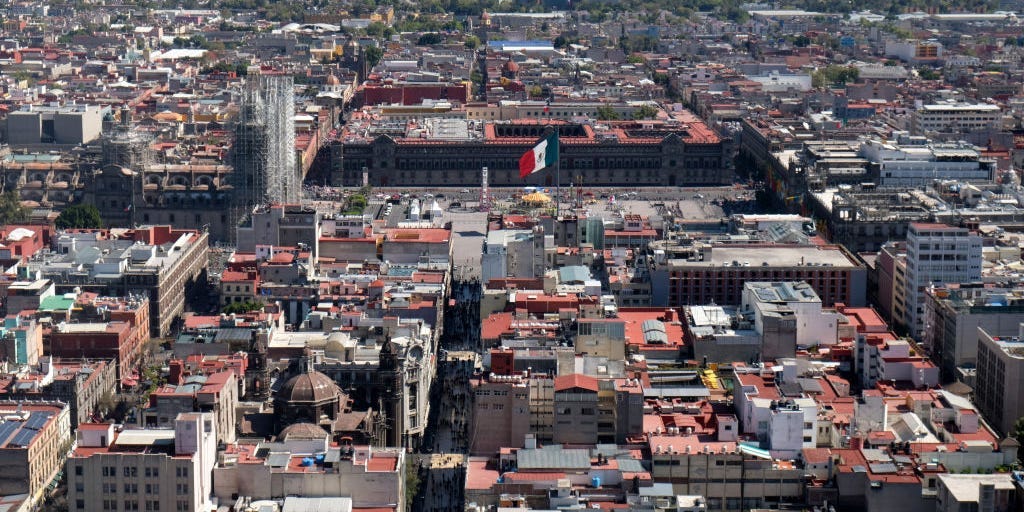- Mexico City could run out of drinking water by June 26, an event locals call “Day Zero.”
- Three years of low rainfall and high temperatures have worsened the city’s water crisis.
- The Cutzamala water system, which provides water to millions, operates now at 28% capacity.
Oh wow the water wars are starting a few years earlier than I anticipated.
Mankind better watch out. Next it’ll be air.
Oh, it’s already being sold.

Those things are awesome. They weigh next to nothing, the small ones have 60 inhales in them, and a single hit is night and day when running at high altitude. A buddy didn’t have time to acclimate before a race, so we got him one as a joke, and it unironically helped him a lot
As Bo said, “Twenty thousand years of this, seven more to go.”
Texas should get ready for a ton of people heading north. Give a person a choice of dying from no water or going where there is water and we all know what will happen.
This will probably happen on a global scale. The southern hemisphere will be too hot at some point.
Is the Southern Hemisphere hotter than the North?
Yes. Well no, but yes. Hemisphere on the whole? No. Land in the hemisphere? No. Land in the hemisphere that isn’t Antarctica? Yes, it’s much more likely to be located closer to the equator. Of the 6 inhabited continents 3 (North America, Europe, and Asia) are entirely located in the northern hemisphere.
You have some areas like Patagonia that are akin to somewhere like europe, but the equator is lower on every continent it passes through than you probably think. The equator in South America is found in the Amazon basin. In Africa it’s in in the Congo and a bit above Nairobi (Johannesburg is the northernmost major city in Africa below the southern tropics). In the Asian sphere it passes through Indonesia. About half of Australia is tropical.
For another comparison the top of the Tropic of Cancer (northern one) is in the middle of the Sahara, below New Delhi, right above Hong Kong, and about in the middle of Mexico.
I assume it has to do with the fact that along the equator it’s typically warmer and the equator runs through the northern part of South America. So if temperatures go up they’ll go up there first and head north south respectively. I don’t think they meant Souther Hemisphere as much as they mean Southern Mexico / South America.
I just watched a whole Astrum video about this. It’s less about one being hotter than the other and more about the seasons being more extreme. The orbit of our planet is actually a little egg shaped, and the closest we pass to the sun happens to be in early January. In the north, due to our tilt, it happens during winter, giving us a more mild season. In the south, the opposite is true. They have hotter summers and colder winters than we do.
The Southern hemisphere gets more extereme seasons. Earths orbit is eliptical and the point where its closest to the sun lines up with southern hemisphere summer making it hotter (and making northern hemisphere winter milder) The same goes for winter with the earth being furthest from the sun roughly during winter in the southern hemisphere. As the earths axis proceeds this effect swaps hemispheres every now and then. (5000 years iirc?)
They are: haven’t you noticed how much of a hard-on they’ve got for shooting and/or imprisoning border-crossers?
Ah, I remember back when idiots thought climate change meant the world would be under water. Turns out it actually means a lot less water will be available.
Less water where you need it and more where you don’t want it.
It will be either too much water or no water.
Edit: i just went to check how my country is doing water wise:
Germany is one of the regions with the highest water loss worldwide. Since 2000, the country has lost 2.5 cubic kilometres of water per year. In the years 2019 to 2021, record low groundwater levels below the long-term lowest groundwater levels were recorded at the measuring points in many places.
Seems we already know
Here’s data for other contries for those interested; https://www.wri.org/data/aqueduct-40-country-rankings
deleted by creator
Some areas will be under more saltwater than now, like Florida and the Netherlands. Some areas will be inhospitable due to consistent heat and lack of FRESHwater like Mexico, Northern Africa, India, etc.
There is also a mix: salty water that won’t submerge land permanently, but that will reach more and more inland across rivers during high tides. River Mekong comes to mind, along which rice is cultivated and that already now suffers from this phenomenon. Salty water on land means you will not grow anything there anymore. The Mekong delta produces rice that is used to feed an incredibly high number of people in Asia.
In Brazil there was a mega flooding in the south recently, I knew some people there and they said it felt very apocalyptic. This is most definitely not normal climate.
Also they found some arid (like desert arid) zones recently in Brazil for the first time. It used to be semi-arid.
deleted by creator
Desalination on a small scale is fine.
Desalination on a large scale would be its own form of environmental catastrophe.
So this is the Warning from Mexico I’ve been hearing about.







